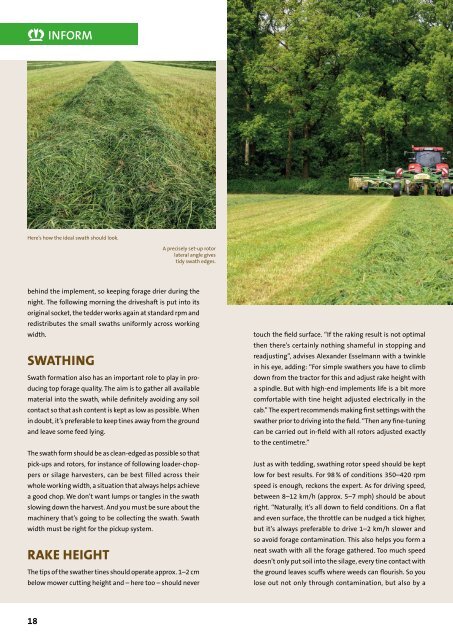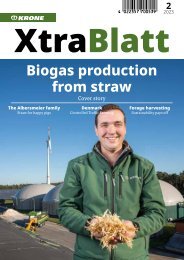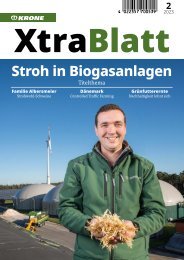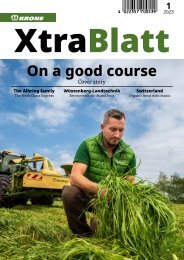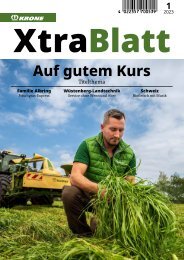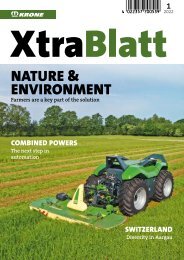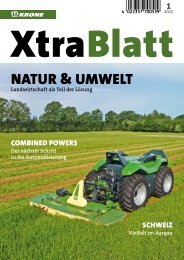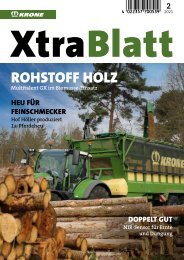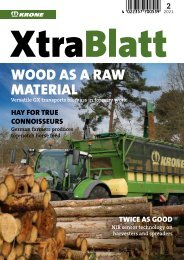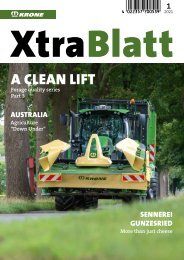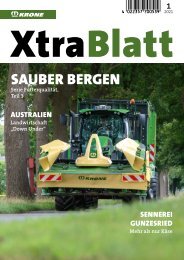XtraBlatt Issue 02-2020
Create successful ePaper yourself
Turn your PDF publications into a flip-book with our unique Google optimized e-Paper software.
INFORM<br />
cardanic rotor suspension ensures that the front wheels of<br />
the rotor rise first. On setting down, the rear wheels hit the<br />
ground first so that the tines are always kept off the ground.<br />
TYRE PRESSURE<br />
Don’t miss out on checking tyre pressures. If these don’t<br />
match on all tyres, perfect swathing isn’t possible. Alexander<br />
Esselmann: “Especially when swathers are delivered, the<br />
tyres can have a very high pressure. This stops the implements<br />
moving around on the transport truck, for instance.<br />
But too high pressure in the field reduces shock absorbance.<br />
Resultant bouncing means tines can end-up kicking dirt.<br />
Swather tyres tend to be larger now. 710 wheels can be<br />
ordered for the frame, with up to 18” wheels available for<br />
Here’s how the ideal swath should look.<br />
behind the implement, so keeping forage drier during the<br />
night. The following morning the driveshaft is put into its<br />
original socket, the tedder works again at standard rpm and<br />
redistributes the small swaths uniformly across working<br />
width.<br />
SWATHING<br />
Swath formation also has an important role to play in producing<br />
top forage quality. The aim is to gather all available<br />
material into the swath, while definitely avoiding any soil<br />
contact so that ash content is kept as low as possible. When<br />
in doubt, it’s preferable to keep tines away from the ground<br />
and leave some feed lying.<br />
The swath form should be as clean-edged as possible so that<br />
pick-ups and rotors, for instance of following loader-choppers<br />
or silage harvesters, can be best filled across their<br />
whole working width, a situation that always helps achieve<br />
a good chop. We don’t want lumps or tangles in the swath<br />
slowing down the harvest. And you must be sure about the<br />
machinery that’s going to be collecting the swath. Swath<br />
width must be right for the pickup system.<br />
RAKE HEIGHT<br />
A precisely set-up rotor<br />
lateral angle gives<br />
tidy swath edges.<br />
The tips of the swather tines should operate approx. 1–2 cm<br />
below mower cutting height and – here too – should never<br />
touch the field surface. “If the raking result is not optimal<br />
then there’s certainly nothing shameful in stopping and<br />
readjusting”, advises Alexander Esselmann with a twinkle<br />
in his eye, adding: “For simple swathers you have to climb<br />
down from the tractor for this and adjust rake height with<br />
a spindle. But with high-end implements life is a bit more<br />
comfortable with tine height adjusted electrically in the<br />
cab.” The expert recommends making first settings with the<br />
swather prior to driving into the field. “Then any fine-tuning<br />
can be carried out in-field with all rotors adjusted exactly<br />
to the centimetre.”<br />
Just as with tedding, swathing rotor speed should be kept<br />
low for best results. For 98 % of conditions 350–420 rpm<br />
speed is enough, reckons the expert. As for driving speed,<br />
between 8–12 km/h (approx. 5–7 mph) should be about<br />
right. “Naturally, it’s all down to field conditions. On a flat<br />
and even surface, the throttle can be nudged a tick higher,<br />
but it’s always preferable to drive 1–2 km/h slower and<br />
so avoid forage contamination. This also helps you form a<br />
neat swath with all the forage gathered. Too much speed<br />
doesn’t only put soil into the silage, every tine contact with<br />
the ground leaves scuffs where weeds can flourish. So you<br />
lose out not only through contamination, but also by a<br />
poorer regrowth standard for the next cuts”, adds Alexander<br />
Esselmann.<br />
LATERAL ANGLE<br />
A substantial influence on rotor rake performance and swath<br />
formation – the factors affected output of the following harvest<br />
machine – is the angle setting of the rotor (or the front<br />
rotor with multi-rotor machines). This should always slope<br />
down in the direction of the swath. Tines take increasingly<br />
more forage material with them on their way towards the<br />
swath and the weight causes them to bend slightly, thus<br />
altering their height above ground surface. Lateral angle<br />
setting allows this to be compensated for, helping produce<br />
a well-shaped swath with clearly defined edges.<br />
Poor lateral angle setting can usually be seen right away<br />
in the shape of the swath. Material left lying on both sides<br />
is also a sure sign that the angle’s wrong. Adjustment is<br />
simply and rapidly carried out directly on the rear gauge<br />
wheels of each rotor.<br />
All Krone Swadro swathers are equipped with “Jet Effect”<br />
technology: on lifting the implement during operation, the<br />
the rotors. Larger and wider wheels have a bigger contact<br />
area and so help protect the grass sward. The wider the<br />
tyre, the less the ground pressure – and this can make a big<br />
difference, especially in wet ground conditions. Bigger tyres<br />
also avoid feed contamination and protect sward quality in<br />
aftermaths. And the number of wheels per rotor helps too in<br />
preventing field surface damage. With us in Krone, between<br />
four to eight wheels are possible. The more wheels mounted<br />
under the rotor, the more precisely can ground conditions<br />
be adjusted for.”<br />
Rotor suspension settings are dependent on field and<br />
ground conditions too. Not enough free play can lead to<br />
soil compaction or sinking of the rotor support wheels in<br />
wet ground. Here, the rotor suspension movement should<br />
be tendentially eased. If the field surface is very hard, or<br />
steep, suspension travel should be reduced to stop the rotor<br />
“floating” or hopping and leaving forage lying.<br />
Coming in your next <strong>XtraBlatt</strong>: A closer look at actual forage<br />
harvesting. «<br />
Alexander Esselmann:<br />
product specialist for<br />
Krone tedders and swathers.<br />
18 19


